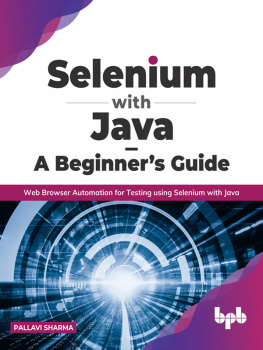Mr. Jones plans to have free step-by-step demonstration webinars, videos, and live trainings walking people through concepts of Selenium and QTP/UFT from A - Z. The material will teach/train individuals the fundamentals of the programming language, fundamentals of Selenium and QTP/UFT, and important concepts of Selenium and QTP/UFT. All of the webinars, videos, and live training will be directed toward beginners as well as mid-level automation engineers.
Rex Jones Contact Information
Email Address:
LinkedIn: https://www.linkedin.com/in/rexjones34
Books: http://tinyurl.com/Rex-Allen-Jones-Books
Twitter: @RexJonesII
Skype: rex.jones34
Table of Contents
Preface
I am enthused to write an instructional book on Java because I have talked with many testers who can relate to the frustration caused by the lack of information to learn Java for automation testing. Java is one of the programming languages for Selenium. A common challenge with new automation testers is learning how to program. Therefore, this book is designed to help an absolute beginner learn Java. The purpose of this book is to fill a need of automation testers who are forced to hurry past the programming component of automation, leading to a struggle with working in Selenium.
Target Audience
The target audience is beginners with little to no knowledge of Java. Beginners are people new to Selenium and Java, and have a desire to establish a deep foundation of Java principles.
Why learn Java?
Java is a powerful programming language that is frequently and commonly implemented in the Information Technology (IT) industry. Java programmers are in high demand in the IT field and being able to code automation scripts in Java will make you a commodity to any quality assurance testing team. There are many Java forums (message boards) online that support Java programmers in need of a solution for a problem. Learning Java and Selenium is a great combination that will make any quality assurance tester effective on an automation project.
About the Author

Rex Allen Jones II is a QA/Software Tester with a passion for sharing knowledge about testing software. He has been watching webinars, attending seminars, and testing applications since February 2005. Mr. Jones graduated from DeVry University in June 1999 with a Bachelors of Science degree in Computer Information Systems (CIS).
Currently, Rex is a Consultant and former Board of Director for User Group: Dallas / Fort Worth Mercury User Group (DFWMUG) and member of User Group: Dallas / Fort Worth Quality Assurance Association (DFWQAA). In addition to his User Group memberships, he is a Certified Software Tester Engineer (CSTE) and has a Test Management Approach (TMap) certification.
Mr. Jones advice for people interested in Functional Automation Testing is to learn the programming language. This advice led him to write two books (Part 1 & Part 2) You Must Learn VBScript for QTP/UFT geared towards VBScript which is the programming language for Unified Functional Testing (UFT) formerly known as Quick Test Professional (QTP). In addition, one book Part 1 Java 4 Selenium WebDriver and an upcoming book Part 2 Java 4 Selenium WebDriver geared toward Java which is one of the programming languages for Selenium.
About the Editor

When Samantha Mann is not improving the contents of a document through constructive editing marks and remarks, she is enjoying life as a professional in Dallas, Texas. Samantha is a User Experience guru in the realms of research and design, and works as an Information Technology consultant. Outside of work her hobbies include the typical nerd-type fun of freelance editing, reading, writing, and binge watching Netflix with her pitbull.
Connect with Samantha:
Samantha.danae.mann@gmail.com
https://www.linkedin.com/pub/samantha-mann/84/9b7/100
Copyright, Legal Notice, and Disclaimer
This publication is protected under the US Copyright Act of 1976. All rights are reserved including resale rights which applies to international, federal, state, and local laws. The purchaser is not allowed to share or sell this book to anyone.
Please note that much of this publication is based on personal experience and anecdotal evidence. The author has made every reasonable attempt to produce accurate content in this book. He assumes no responsibility for unknown errors or omissions. Therefore, the purchaser should use this information as he/she sees fit.
Any trademarks, service marks, product names or named features are assumed to be the property of their respective owners and used only for reference.
Copyright 2016 Test 4 Success, LLC. All rights reserved worldwide .
ASIN : B01CO4E000
Acknowledgements
I would like to express my gratitude to my wife Tiffany, children Olivia Rexe and Rex III, editor Samantha Mann, family, friends, and the many people who provided encouragement. Writing this book took time and your support helped pushed this book forward.
Thank You,

Rex Allen Jones II
Chapter 1
Introduction to Java
Overview
Java is a powerful programming language developed by Sun Microsystems. It is a widely used object-oriented language that revolutionized the web. In addition to revolutionizing the web, Java is used in many devices, such as cell phones. The Java Development Kit (JDK) and one of the Integrated Development Environments (IDE), such as Eclipse, must be downloaded and installed in order to use Java.
The following links are valid for downloading Java Development Kit (JDK) and Eclipse IDE at the time of writing this book:
Download Java Development Kit (JDK)
http://www.oracle.com/technetwork/java/javase/downloads/jdk8-downloads-2133151.html
Download Eclipse IDE
https://eclipse.org/downloads/
Once the JDK and Eclipse IDE have been downloaded and installed, statements can be written and compiled. Statements are referred to as codea line or lines of information written in a particular syntax . The key to all programming languages is the syntax. Syntax is a set of rules that specifies a structured combination of words and symbols. If not structured correctly, an error occurs to prevent the statements from compiling.
Compiling statements is performed via a compiler. A compiled language refers to a special program that retrieves the statements developed by a programmer and then translates the statements into an understandable machine language. A computer processor is then able to use the machine language once the statements are translated . It is important to know that comments are statements but ignored and never causes an error. Comments are notes that help programmers understand the program and/or other statements. The following are two types of comments:





![Rahul Shetty [Rahul Shetty] - Hands-On Automation Testing with Java for Beginners](/uploads/posts/book/119398/thumbs/rahul-shetty-rahul-shetty-hands-on-automation.jpg)





